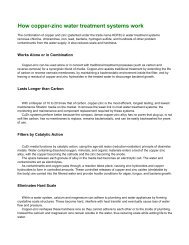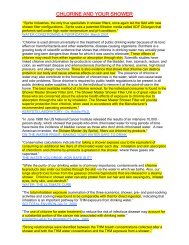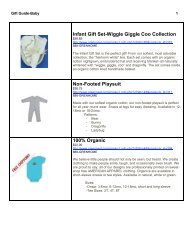Do you knwo what's in your drinking water? - Green Nest
Do you knwo what's in your drinking water? - Green Nest
Do you knwo what's in your drinking water? - Green Nest
You also want an ePaper? Increase the reach of your titles
YUMPU automatically turns print PDFs into web optimized ePapers that Google loves.
Radium 226 and<br />
Radium 228<br />
(comb<strong>in</strong>ed)<br />
none 7<br />
----------<br />
zero<br />
Uranium zero 30 ug/L<br />
as of<br />
12/08/03<br />
radiation<br />
5 pCi/L Increased risk of cancer Erosion of natural<br />
deposits<br />
Increased risk of cancer, kidney<br />
toxicity<br />
Erosion of natural<br />
deposits<br />
Notes<br />
1 Def<strong>in</strong>itions:<br />
Maximum Contam<strong>in</strong>ant Level (MCL) - The highest level of a contam<strong>in</strong>ant that is allowed <strong>in</strong><br />
dr<strong>in</strong>k<strong>in</strong>g <strong>water</strong>. MCLs are set as close to MCLGs as feasible us<strong>in</strong>g the best available treatment<br />
technology and tak<strong>in</strong>g cost <strong>in</strong>to consideration. MCLs are enforceable standards.<br />
Maximum Contam<strong>in</strong>ant Level Goal (MCLG) - The level of a contam<strong>in</strong>ant <strong>in</strong> dr<strong>in</strong>k<strong>in</strong>g <strong>water</strong><br />
below which there is no known or expected risk to health. MCLGs allow for a marg<strong>in</strong> of safety<br />
and are non-enforceable public health goals.<br />
Maximum Residual Dis<strong>in</strong>fectant Level (MRDL) - The highest level of a dis<strong>in</strong>fectant allowed <strong>in</strong><br />
dr<strong>in</strong>k<strong>in</strong>g <strong>water</strong>. There is conv<strong>in</strong>c<strong>in</strong>g evidence that addition of a dis<strong>in</strong>fectant is necessary for<br />
control of microbial contam<strong>in</strong>ants.<br />
Maximum Residual Dis<strong>in</strong>fectant Level Goal (MRDLG) - The level of a dr<strong>in</strong>k<strong>in</strong>g <strong>water</strong><br />
dis<strong>in</strong>fectant below which there is no known or expected risk to health. MRDLGs do not reflect<br />
the benefits of the use of dis<strong>in</strong>fectants to control microbial contam<strong>in</strong>ants.<br />
Treatment Technique - A required process <strong>in</strong>tended to reduce the level of a contam<strong>in</strong>ant <strong>in</strong><br />
dr<strong>in</strong>k<strong>in</strong>g <strong>water</strong>.<br />
2 Units are <strong>in</strong> milligrams per liter (mg/L) unless otherwise noted. Milligrams per liter are<br />
equivalent to parts per million.<br />
3 EPA's surface <strong>water</strong> treatment rules require systems us<strong>in</strong>g surface <strong>water</strong> or ground <strong>water</strong><br />
under the direct <strong>in</strong>fluence of surface <strong>water</strong> to (1) dis<strong>in</strong>fect their <strong>water</strong>, and (2) filter their <strong>water</strong> or<br />
meet criteria for avoid<strong>in</strong>g filtration so that the follow<strong>in</strong>g contam<strong>in</strong>ants are controlled at the<br />
follow<strong>in</strong>g levels:<br />
• Cryptosporidium: (as of1/1/02 for systems serv<strong>in</strong>g >10,000 and 1/14/05 for systems<br />
serv<strong>in</strong>g





